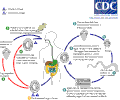
No higher resolution available.
This file is from Wikimedia Commons and may be used by other projects.
The description on its file description page there is shown below.
Eggs of Hymenolepis nana are immediately infective when passed with the stool and cannot survive more than 10 days in the external environment . When eggs are ingested by an arthropod intermediate host (various species of beetles and fleas may serve as intermediate hosts), they develop into cysticercoids, which can infect humans or rodents upon ingestion and develop into adults in the small intestine. A morphologically identical variant, H. nana var. fraterna, infects rodents and uses arthropods as intermediate hosts. When eggs are ingested (in contaminated food or water or from hands contaminated with feces), the oncospheres contained in the eggs are released. The oncospheres (hexacanth larvae) penetrate the intestinal villus and develop into cysticercoid larvae . Upon rupture of the villus, the cysticercoids return to the intestinal lumen, evaginate their scoleces , attach to the intestinal mucosa and develop into adults that reside in the ileal portion of the small intestine producing gravid proglottids . Eggs are passed in the stool when released from proglottids through its genital atrium or when proglottids disintegrate in the small intestine . An alternate mode of infection consists of internal autoinfection, where the eggs release their hexacanth embryo, which penetrates the villus continuing the infective cycle without passage through the external environment . The life span of adult worms is 4 to 6 weeks, but internal autoinfection allows the infection to persist for years.
| Public domainPublic domainfalsefalse
|
https://creativecommons.org/publicdomain/mark/1.0/PDMCreative Commons Public Domain Mark 1.0falsefalse
File history
Click on a date/time to view the file as it appeared at that time.
| Date/Time | Thumbnail | Dimensions | User | Comment |
|---|
| current | 14:32, 18 October 2007 |  | 520 × 435 (27 KB) | wikimediacommons>Filip em | Eggs of Hymenolepis nana are immediately infective when passed with the stool and cannot survive more than 10 days in the external environment . When eggs are ingested by an arthropod intermediate host (various species of beetles and fleas may serve as |
File usage
The following page uses this file:


